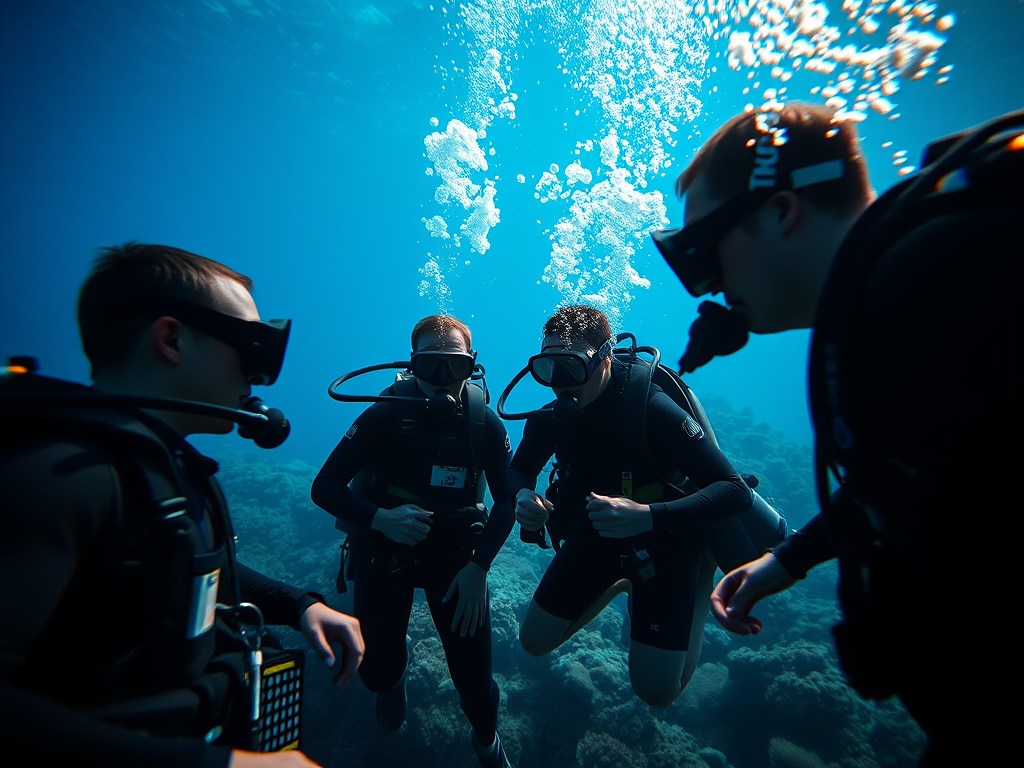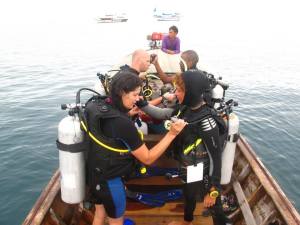Buddy Diving: The Key to Safety – A Dive Instructor’s Perspective on Gear Checks and Dive Partnerships

The Guide to Performing Dive Buddy Checks for Safe Diving
Conducting Dive Buddy Checks: A Comprehensive Manual for Ensuring Dive Safety
Before you embark on your scuba diving adventure, it is essential to emphasize the significance of conducting a buddy check. This vital procedure acts as a determining factor between a safe and enjoyable underwater experience and a potentially hazardous situation. Our in-depth guide will cover the importance of buddy checks, highlight the relevance of the widely recognized BWRAF safety protocol, provide mnemonic techniques for easy recall of BWRAF, outline the advantages of incorporating BWRAF into water activities, and offer essential tips for preparing for PADI Rescue Diver certification.
Importance of Performing Buddy Checks
So why should you bother with buddy checks? Well, aside from being a basic safety requirement, buddy checks significantly reduce the chances of accidents and equipment malfunctions underwater. By taking a few minutes before each dive to go through a thorough buddy check, you and your buddy can ensure that each other’s equipment is functioning properly and that you are both prepared for the adventure ahead.
Buddy checks are essential for several reasons. Not only do they fulfill safety regulations, but they also play a crucial role in minimizing underwater accidents and equipment issues. Prior to every dive, investing a few minutes in conducting a comprehensive buddy check guarantees that both you and your diving partner have properly functioning equipment and are fully prepared for the upcoming adventure.
When it comes to scuba diving, safety should always be the top priority. The underwater world is a beautiful and captivating place, but it can also be unpredictable and unforgiving. That’s why it’s crucial to establish a routine of performing buddy checks before every dive.
During a buddy check, you and your dive buddy will inspect each other’s equipment to make sure everything is in working order. This includes checking the air supply, adjusting the buoyancy compensator devices (BCDs), reviewing the weight system, inspecting the regulator, and examining the mask and fins. By going through this checklist together, you can identify any potential issues or malfunctions before they become a problem underwater.
Step-by-Step Instructions for Conducting a Thorough Buddy Check
Performing a buddy check is easier than you might think! Here’s a step-by-step guide to help you conduct a comprehensive check:
- Check the air supply: Start by checking each other’s air tanks to ensure they are full and properly secured.
- Adjust the buoyancy compensator devices (BCDs): Make sure the BCDs are securely fastened and properly adjusted for a comfortable fit.
- Review the weight system: Verify that the weight belts or integrated weight systems are correctly positioned and fastened.
- Inspect the regulator: Check the connection between the regulator and the tank, making sure it is secure and leak-free.
- Examine the mask and fins: Ensure that the mask is properly fitted, the snorkel is clear, and the fins are securely attached.
- Communicate the dive plan: Discuss the dive plan, signals, and emergency procedures to ensure everyone is on the same page.
By following these steps, you can have peace of mind knowing that you and your buddy are well-prepared for the dive ahead. However, it’s important to be aware of some common mistakes that divers often make during buddy checks.
Tips for Avoiding Common Errors When Conducting a Buddy Check
Even though buddy checks are straightforward, there are a few common mistakes that are worth highlighting:
Ensure that your buddy is attentive and actively participating in the check. Verify that all equipment is properly secured and adjusted to fit each diver comfortably. Inspect the air supply gauge to ensure it is reading accurately and has sufficient air. Check that the regulator is functioning properly by taking a few breaths from it. Verify that the mask creates a proper seal on the face and that the fins are securely fastened. Double-check the weight system to ensure it is distributed evenly and easy to release if necessary. Confirm that both divers understand the hand signals and communication methods to be used underwater. Review the dive plan and emergency procedures with your buddy to ensure both are on the same page. Perform a final visual inspection of each other’s equipment to catch any overlooked issues. Remember, a thorough buddy check is crucial for a safe and enjoyable dive experience.
- Rushing through the check: Take your time and give each item the attention it deserves. A thorough buddy check should never be rushed, as it is a critical step in ensuring your safety.
- Assuming everything is okay: Double-check each item, even if you think it was already checked. It’s easy to overlook something or make a mistake, so it’s always better to be safe than sorry.
- Skipping communication: Communication is key, so make sure to discuss the dive plan and emergency procedures. This ensures that everyone is aware of what to do in case of an emergency and helps prevent confusion underwater.
- Forgetting the final safety check: Before descending, do one final check to ensure everything is in order. It’s easy to get caught up in the excitement of the dive, but taking a few extra moments for a final safety check can make all the difference.
Remember, buddy checks are not just a formality – they are a crucial part of ensuring a safe and enjoyable diving experience. By taking the time to perform thorough checks and avoiding common mistakes, you and your buddy can dive with confidence, knowing that you are well-prepared for whatever the underwater world has in store.
Comprehending the BWRAF Safety Protocol: US English
If you’ve been in the diving community long enough, you’ve probably heard of BWRAF. This acronym stands for Buoyancy, Weights, Releases, Air, and Final Check – a five-step safety protocol that every diver should follow. Let’s dive deeper into each step:
The Significance of Each Step in BWRAF
Each letter in BWRAF represents an important aspect of dive safety:
- Buoyancy: Proper buoyancy control is essential for a safe and comfortable dive. Ensure your BCD is adjusted correctly.
- Weights: Verify that your weight system is correctly positioned and balanced for optimal control.
- Releases: Check that all buckles and straps on your gear are secure and will not come undone during the dive.
- Air: Confirm that your air supply is properly connected, and you have enough air for the planned dive time.
- Final Check: Take a moment to do a final overall check of your equipment, making sure everything is in order.
Application of BWRAF in Various Water Environments
Whether you’re diving in a tropical reef or exploring a deep cave, the BWRAF protocol applies to all types of diving environments. However, it’s important to adapt the protocol to suit specific conditions. For example, in strong current dives, extra attention should be given to the buoyancy and release steps to ensure stability and prevent entanglement.
The BWRAF protocol is applicable in various diving environments, whether it be a tropical reef or a deep cave. However, it is crucial to adjust the protocol according to specific conditions. In instances of strong current dives, particular emphasis should be placed on buoyancy and release steps to maintain stability and avoid entanglement. OK.
Moreover, when diving in colder waters, divers need to consider the impact of exposure suits on their buoyancy and weight distribution. Thicker wetsuits or drysuits can compress at depth, affecting buoyancy levels and potentially causing uncontrolled descents if not properly managed. It is crucial for divers to adjust their weight systems accordingly to maintain proper trim and buoyancy control throughout the dive.
Additionally, in low visibility environments such as murky lakes or deep wrecks, the releases step becomes even more critical. Ensuring that all buckles and straps are not only secure but also easily accessible in limited visibility can make a significant difference in emergency situations. Divers must practice muscle memory drills to swiftly locate and operate their gear’s releases without hesitation, enhancing their overall safety and preparedness underwater.
Memorization Techniques for BWRAF
Remembering the steps of BWRAF may seem challenging at first, but with the right mnemonic devices, you can easily commit them to memory.
Understanding and implementing the BWRAF protocol is crucial for scuba divers as it ensures a safe and systematic approach to diving. Each letter in BWRAF represents a critical step in the pre-dive safety check: Buoyancy, Weights, Releases, Air, and Final Check. By following these steps diligently, divers can minimize risks and enjoy a smooth diving experience.
Use mnemonic techniques for better recall of the acronym BWRAF.
Here are a few fun and easy-to-remember devices to help you recall each step of BWRAF:
- “Big Wave Rides Are Fun”: Buoyancy, Weights, Releases, Air, Final Check.
- “Best Way to Rewind a Film”: Buoyancy, Weights, Releases, Air, Final Check.
- “Bring Wood for Roasting Apples Freely”: Buoyancy, Weights, Releases, Air, Final Check.
These mnemonic devices provide divers with creative ways to remember the sequence of BWRAF steps, making it easier to perform the pre-dive safety check accurately and efficiently.
Practice Drills to Solidify BWRAF in Your Mind
To truly internalize BWRAF, practice drills can enhance your familiarity with the steps. Set aside time before each dive to perform the protocol repeatedly until it becomes second nature. Repetition is key in building muscle memory and ensuring that you won’t miss a step when it matters most.
Engaging in mock scenarios where you go through the BWRAF process under different conditions, such as low visibility or simulated equipment malfunctions, can further reinforce your ability to execute the protocol under various circumstances. By practicing consistently and incorporating different variables into your drills, you can sharpen your skills and increase your confidence in applying the BWRAF checklist effectively.
Exploring the Benefits of BWRAF in Water Activities
Now that you are well-versed in the importance of buddy checks and the BWRAF safety protocol, let’s delve into how implementing these practices can enhance safety in various water activities.
Understanding the intricacies of the BWRAF protocol is crucial for ensuring a safe and enjoyable experience in water activities. Beyond just a checklist, BWRAF stands for: Begin with a buddy check, Water entry, Regulator recovery, Air check, and Final check. Each step plays a vital role in mitigating risks and promoting a culture of safety among divers and swimmers.
How BWRAF Enhances Safety in Diving and Swimming
By following the steps of BWRAF, divers and swimmers can greatly minimize the risk of accidents and equipment failures. The protocol ensures that crucial elements, such as buoyancy control, air supply, and equipment integrity, are carefully monitored before embarking on any water adventure. This leads to a safer and more enjoyable experience for everyone involved.
Moreover, the discipline instilled by consistently practicing BWRAF fosters a sense of responsibility and attentiveness among water enthusiasts. This mindset not only enhances personal safety but also contributes to a collective culture of vigilance and support within the water activity community.
Instances in Real-Life Where BWRAF Became a Lifesaving Tool
Multiple instances have been recorded wherein adherence to the BWRAF protocol has led to the preservation of lives. Take, for instance, a scenario involving a diver whose air supply got detached at a depth of 30 meters. Due to a meticulous buddy check and the application of BWRAF, the diver’s companion promptly identified the problem and offered assistance, effectively averting a potentially lethal circumstance.
Another compelling instance showcases how BWRAF extends beyond individual safety to create a network of guardianship underwater. In a group diving expedition, a member experienced a sudden equipment malfunction. Through the collective adherence to BWRAF, fellow divers swiftly intervened, demonstrating the power of preparedness and teamwork in averting emergencies.
PADI Rescue Diver Preparation: Key Recommendations
If you’re looking to take your diving skills to the next level and become a PADI Rescue Diver, proper preparation is vital. Here are some essential tips to get you started:
Physical and Mental Readiness for PADI Rescue Diver Course
Completing the PADI Rescue Diver course necessitates both physical fitness and mental readiness. Regular exercise and a healthy lifestyle will boost your endurance and overall performance in training. It is also important to be mentally prepared to tackle difficult situations and make prompt decisions when under pressure.
PADI Rescue Diver Training Equipment Checklist
Ensure that you possess all required gear before starting the PADI Rescue Diver program. The equipment checklist typically comprises a BCD, gauged regulator, weights, exposure suit, dive computer, compass, mask, fins, snorkel, and signaling device. Verifying your equipment guarantees a seamless and secure training encounter.
By now, you should have a solid understanding of the importance of buddy checks and the significance of the BWRAF safety protocol. Remember, safety should always be your top priority while enjoying the adventure-filled world of scuba diving. So, take your time, perform thorough buddy checks, and always follow the BWRAF protocol. Happy diving!

